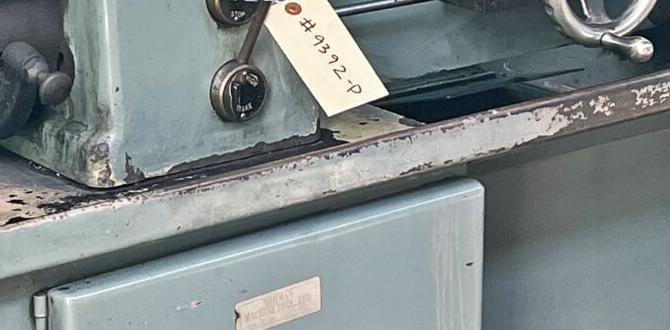Crafting Your Own Wood Lathe Chuck Key: An Essential DIY Project
For any woodworker who owns a lathe, the chuck is an indispensable tool, the crucial interface between the spinning workpiece and the tool itself. And at the heart of that interface lies the chuck key – the humble yet vital component that tightens and loosens the jaws. While readily available at hardware stores and specialized woodworking suppliers, there’s a unique satisfaction, and often a practical necessity, in being able to craft your own wood lathe chuck key homemade. Whether you’re facing a worn-out original, need a custom fit for a particular chuck, or simply enjoy the challenge of creating your own tools, this DIY project offers a rewarding experience.
The beauty of a homemade chuck key lies in its adaptability and the tangible skill it represents. Beyond the purely functional aspect, the process of creating one hones your understanding of metalworking basics, precision, and the importance of specific tool geometry. It’s a project that can be tackled with relatively common tools and a bit of patience, transforming raw materials into a reliable piece of workshop equipment.
Why Consider a Homemade Wood Lathe Chuck Key?
Several compelling reasons might lead you down the path of creating your own wood lathe chuck key homemade. The most straightforward is cost-effectiveness. While not exorbitant, chuck keys do add up, especially if you have multiple chucks with different key sizes or if you tend to misplace them. For those venturing into restoration projects or acquiring older lathes, finding the correct replacement key can sometimes be a challenge. A homemade solution bypasses this sourcing issue entirely.
Furthermore, the desire for a custom fit can be a strong motivator. Some chucks, especially older or less common models, might have slightly out-of-spec keyways. A precisely made homemade key can ensure a snug, secure fit, preventing slippage during operation, which is paramount for safety and effective woodworking. Beyond these practicalities, there’s the inherent satisfaction of self-reliance. Knowing you can fabricate essential tools for your craft builds confidence and deepens your connection with your woodworking journey. It’s about understanding the mechanics of your tools and being able to repair or augment them as needed.
Choosing Your Materials and Design
The foundational element of any wood lathe chuck key homemade endeavor is selecting the right material. For durability and strength, mild steel is generally the preferred choice. You’ll want a material that can withstand the torque required to tighten and loosen your chuck jaws without bending or breaking. Common options include:
Steel Rod: Round steel rods of appropriate diameter are readily available at hardware stores or metal suppliers.
Old Tools: Broken screwdrivers, drill bits, or even hex wrenches can be repurposed. Look for hardened steel that can be re-shaped.
* Steel Plate/Bar: Thicker steel plate or bar stock can also be used, requiring more shaping but offering robustness.
The design of your chuck key is equally important. Most chuck keys have a simple L-shape, with one end designed to engage the keyway on the chuck and the other forming a comfortable handle. The critical dimensions are the diameter of the rod that fits into the chuck’s keyway and the dimensions of the keyway itself. Measure your chuck’s keyway meticulously. The engagement end of your key should be a precise fit – not too loose to allow slipping, and not too tight to bind. Often, a square or hexagonal profile is needed for the tip that enters the chuck.
Step-by-Step Guide to Creating Your Homemade Chuck Key
Building your wood lathe chuck key homemade involves a series of steps, each requiring careful execution.
1. Measurement and Planning:
As mentioned, accurately measure the keyway on your chuck. Note the depth, width, and shape of the recess where the key inserts. Sketch out your desired key design, considering the length of the handle for comfortable leverage.
2. Material Preparation:
If you’re using a steel rod, cut it to your planned length. If repurposing an old tool, cut away the worn or irrelevant parts, leaving a section of solid metal to work with. If using plate or bar stock, cut it to a rough size that allows for shaping.
3. Shaping the Engagement End:
This is the most critical step. If you need a square or hexagonal profile, you’ll likely need to use a grinder or a file to shape the end of your rod or bar stock. Start by removing small amounts of material, checking the fit in your chuck’s keyway frequently. Patience here is key to achieving a precise fit. For a round shaft that fits a round hole, you might just need to grind the tip to a slightly tapered or flatted end that acts as a robust engagement point.
4. Forming the L-Shape:
If your material is a straight rod, you’ll need to bend it into an L-shape. This can be done by heating the steel to a malleable state (red hot) using a torch and then bending it around a vise or a sturdy jig. Alternatively, for smaller keys or softer steels, you might be able to cold-bend it using a vise and a hammer, though this is more challenging.
5. Refining the Fit and Finish:
Once the basic shape is achieved, use files and sandpaper to smooth all edges and refine the engagement tip. Ensure there are no burrs that could snag or damage the chuck. Test the fit in the chuck again. It should slide in smoothly and engage securely.
6. Hardening and Tempering (Optional but Recommended):
For increased durability, you can harden and temper your homemade chuck key. This involves heating the engagement end to a critical temperature (indicated by a cherry red color) and then quenching it rapidly in oil or water. This makes the steel hard but brittle. To reduce brittleness, the metal is then gently reheated to a lower temperature (often indicated by straw or blue colors on the steel) and allowed to cool slowly. This process, known as tempering, restores some toughness. Be aware that this requires a torch and a good understanding of heat-treating principles to avoid damaging the metal.
7. Final Touches:
Clean up your key thoroughly. You might consider adding a grip to the handle, such as wrapping it with tape or heat-shrink tubing, for improved comfort and control.
Safety First When Using Your DIY Chuck Key
While the satisfaction of a completed wood lathe chuck key homemade is immense, safety must remain paramount. Always ensure your key fits snugly into the chuck’s keyway and that you apply pressure in a controlled manner. Never force a chuck key. If it feels tight or binds, stop immediately and investigate. A poorly fitting or fabricated key can slip, leading to unexpected movement of the workpiece or causing damage to the chuck or the key itself. Always disengage the power to your lathe before attempting to tighten or loosen the chuck. Regularly inspect your homemade key for any signs of wear, cracks, or deformation. A damaged key is a safety hazard.
Creating your wood lathe chuck key homemade is more than just a repair or a cost-saving measure; it’s an extension of your woodworking skills. It’s about understanding your equipment at a deeper level and taking pride in your ability to create reliable, functional tools with your own hands. The next time your factory-issued key goes missing or feels less than perfect, you’ll have the knowledge and experience to craft a superior replacement, one that perfectly suits your needs and proudly bears the mark of your own craftsmanship.






